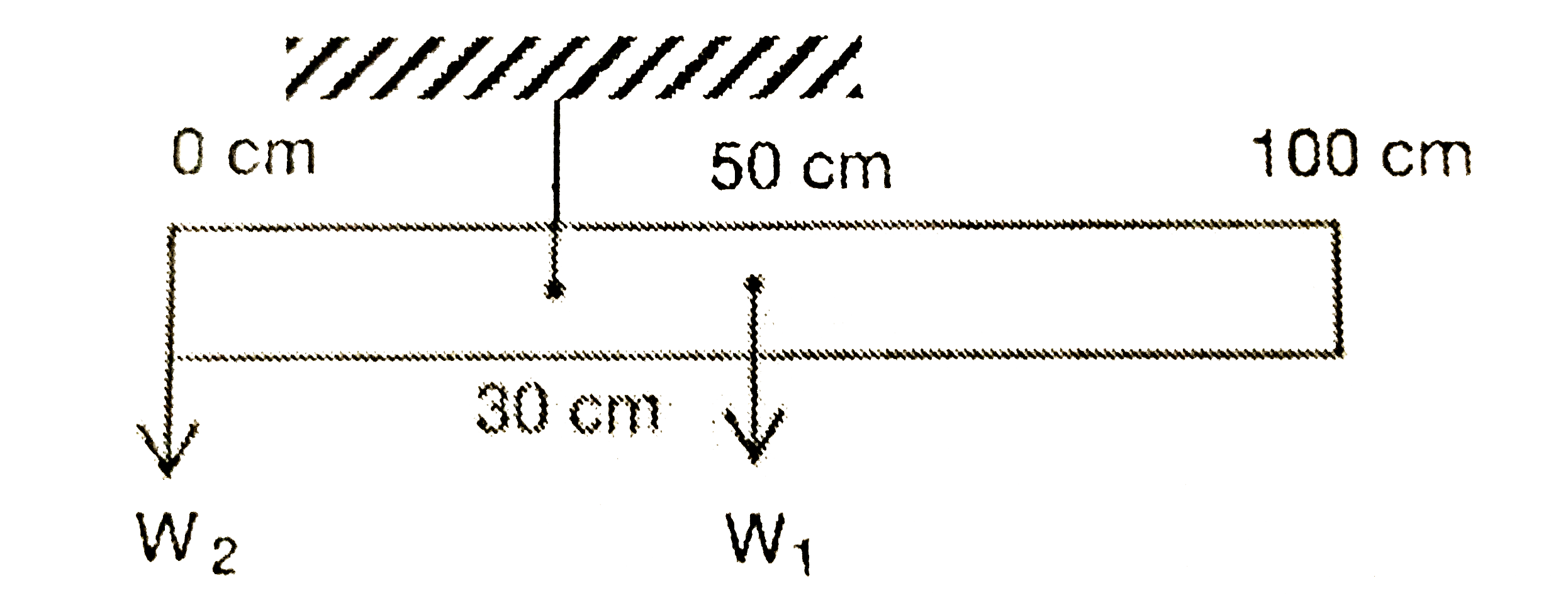A heavy metallic scale of length 1 m has its centre of gravity at 50 cm division. It is suspended at a 30 cm mark. A load of 60gwt has to be tied at its zero cm make to keep it in equilibrium. Calculate the weight of the scale.
The scale is in equilibrium. Thus, according to the principle of moments, the sum of clockwise moments (W1l1) is equal to the sum of anti-clockwise moments (W2l2).

∴W1l1=W2l2
W1= weight of the scale.
l1= distance of centre of gravity of the scale from the point of suspension
=50−30=20cm
W2= load=60 gwt
l2=30cm= distance of load from the point of suspension
∴W1×20cm=60gwt×30cm
∴W1=60gwt×30cm20cm=90gwt
Topper's Solved these Questions
- SIMPLE MACHINESBOOK - PEARSON IIT JEE FOUNDATIONCHAPTER - SIMPLE MACHINESEXERCISE - Very Short Answer Type Questions
30 Videos
- SIMPLE MACHINESBOOK - PEARSON IIT JEE FOUNDATIONCHAPTER - SIMPLE MACHINESEXERCISE - Short Answer Type Questions
13 Videos
- MODERN PHYSICSBOOK - PEARSON IIT JEE FOUNDATIONCHAPTER - MODERN PHYSICSEXERCISE - Level 3
5 Videos
- WAVES MOTION AND SOUND BOOK - PEARSON IIT JEE FOUNDATIONCHAPTER - WAVES MOTION AND SOUND EXERCISE - Level 3
10 Videos
Similar Questions
A solenoid is of length 50cm and has a radius of 2cm. It has 500 turns. Around its central section a coil of 50 turns is wound. Calculate the mutual inductance of the system.
View SolutionTo balance a uniform metre scale suspended at 50 cm mark, a with 200 g weight suspended from it at 20 cm mark, a weight of _________ g must be suspended at 90 cm mark.
View Solution
Knowledge Check
A metre scale is supported on a wedge at its centre of gravity. A body of weight w is suspended from the 15 cm mark and another weight of 30 gram suspended from 71 cm mark balances it the metre scale remains perfectly horizontal. What is the weight of the body? Neglect the weight of the centre scale.
A15 gram wtB18 gram wtC20 gram wtD25 gram wt.A crowbar of length 120cm has its fulcrum situated at a distance of 20cm from the load. The mechanical advantage of the crow bar is
A1B3C5D7An uniform metre scale of weight 50g is balanced at 60cm mark, when a weight of 15g is suspended at 10cm mark. Where must a weight 100g be suspended to balance metre scale.
A72.5cmB70cmC71.5cmD74.5cm
A uniform metre scale of weight 20 gf is supported on a wedge placed at 60 cm mark. If a weight of 30 gf is suspended at 15 cm mark, where should a weight 200 gf be suspended in order to balance the metre scale?
View SolutionA bar of length 1 m is supported at its two ends. The breadth and depth of the bar are 5 cm and 0.5 cm., respectively , A body of mass 0.1 is suspended at the centre of the bar. Calculate the depression produced in the bar.
View SolutionA uniform metre scale 1 m long is suspended at 50 cm division. A known weight of 160 gwt is tied at 80 cm division and the scale is balanced by a weight of 240 gwt tied to the scale at a certain distance from the point of suspension on the opposite side. Calculate this distance.
View SolutionA uniform metre scale is balanced horizontally on a knife edge at a distance of 10 cm from its centre of gravity, when masses of 50 gm and 30 g are suspended from the 5 cm and 90 cm marks of the rod. What is the weight of the rod?
View SolutionA meter scale is balanced at its mid point if a 20N weight is balanced at 20 cm mark and a 30 N weight hanged at x cm mark. Calculate the value of x.
View Solution
